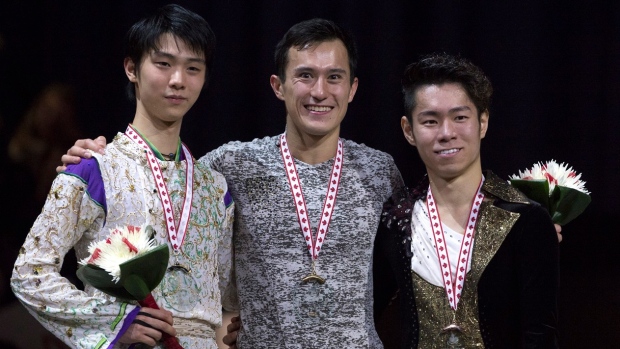Nov 12, 2015
What we've learned from Canada's skaters
We're halfway through the Grand Prix season and what have we taken away from it? TSN's Tracy Wilson examines the progress of Canada's skaters going into the Trophee Eric Bompard event in France this weekend.
By Tracy Wilson

We're halfway through the Grand Prix season and what have we learned?
We've learned that the much-anticipated return of world champions Patrick Chan and Mao Asada of Japan did not disappoint. In fact, they've stepped right back into world title contention.
Patrick's comeback was not without its nervous moments, as his short program showed the reality of being out of the competitive limelight when he fumbled two key jumping passes.
It was a resounding success in the free skate where (after a very shaky warm up) he found his nerve, clicked into the zone and skated one of his best free skates ever. It was quintessential Chan.
He went into a place where his blades took over. And when that happens, it's full speed ahead with deep carving edges, lilting footwork and explosive jumps, done somewhere on the line between reckless abandon and total control. It's good to see him back and back at the top. Chan and World Champion Javier Fernandez of Spain have the top total scores this season after the halfway mark.
We've also learned that the quad is indeed the story again in the men's event. The charge is being led not by just the guys at the top like Fernandez and Yuzuru Hanyu (with three in their free skates), but the young guys coming up as well. Last week in China, we saw hometown favorite - 16-year old Boyang Jin - use his quad lutz-triple toe to put his name in the record books. It's the first time the quad lutz, which has only been done once cleanly in an international competition, has been executed in combination. And his quad lutz combination is recorded as the highest scoring element ever.
Then in the free skate, Boyang became the first to attempt four quads in a program. He currently has three different quads on the go in competition, another first. He wasn't successful in getting them out cleanly this time and his skating between the jumps isn't pretty, but the lutz is spectacular. He made his quad lutz look so easy, it makes me wonder if it will be a situation like Roger Banister's four-minute mile where once the rest of the field sees that it's clearly possible, the flood gates will open and it will become the new norm. We'll see.
World Champion Mao Asada's comeback debut was equally successful, as she triple-axeled her way to the title at her recent Grand Prix in China. We saw her ride her triple axel to silver at the 2010 Vancouver Olympics, but it now looks new and improved. It has looked higher, tighter and more consistent this year than I've it seen in the past.
The beauty of Mao is that her technical strength is matched by her engaging artistry and for me that's what makes her comeback so exciting. Her lack of weaknesses make her unique. Where tripling teenagers are often in vogue these days in the ladies event, Mao is a sobering and positive influence as she has a more ambitious program plan technically than the others and she has the skating skills, musicality and presence to back it up. Throw into the mix her newfound sense of purpose and you have the makings of what could be a knock out season for Asada.
We've finally seen the U.S. women work their way back into contention early on this Grand Prix season. U.S. Women, who used to dominate internationally have not been on the World or Olympic podiums since 2006. Both Gracie Gold and Ashley Wagner have looked fabulous and have put up big numbers to hit personal bests in their first Grand Prix events.
Gracie posted the highest score this year in her free skate at Skate America and Ashley Wagner turned heads with a consistent triple/triple, a sensational new short program and a first place finish over the defending world champion Elizaveta Tuktamysheva at Skate Canada.
Megan Duhamel and Eric Radford will likely have learned after the first three Grand Prix events that, if they want to control their destiny, they'll have to add a second quad throw.
Otherwise, they'll find themselves in the mix with the wily Russian pair of Kavaguti and Smirnov who tried two quad throws in China, landing one and stepping out of the other. As a result of upping the ante technically, they put up big scores - scores that rivalled Megan and Eric's first place marks at Skate Canada. Duhamel and Radford opted out of trying the second quad throw in their free skate as they didn't want to overwhelm themselves with too much too soon, but they looked so strong and polished throughout their performance in Lethbridge that I would be surprised if a second throw quad isn't included in their next Grand Prix later this month in Japan.
In ice dance, we have yet to see all of the contenders. But the 2014 world champions Cappellini and Lanotte from Italy and Canadian world medalists Kaitlyn Weaver and Andrew Poje have the top scores so far.
Kaitlyn and Andrew drew standing ovations for both of their skates in Lethbridge and their short dance has the potential to stand out as one of their best yet. As in all of the disciplines, the top six finishers on the Grand Prix circuit will qualify for the final in Barcelona in early December.
